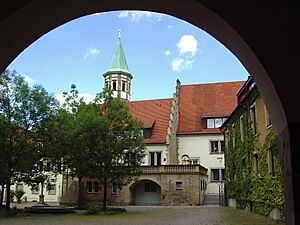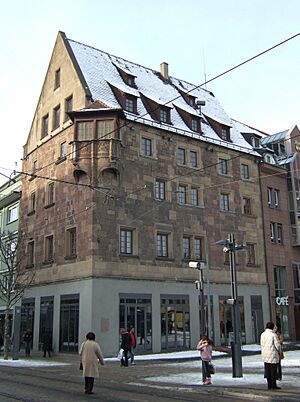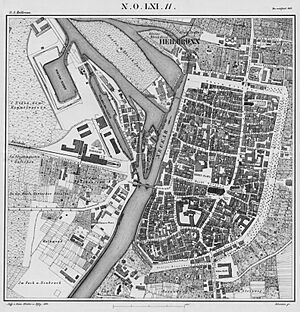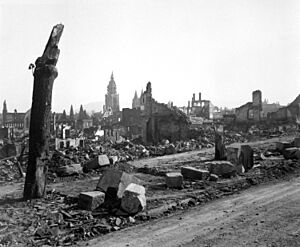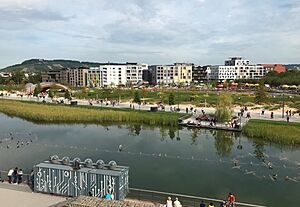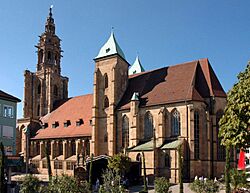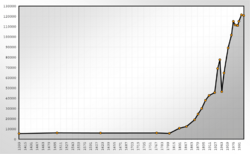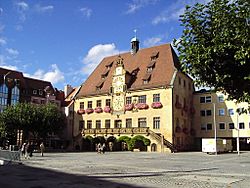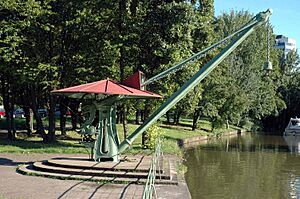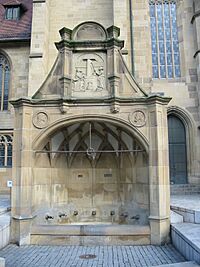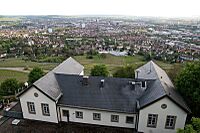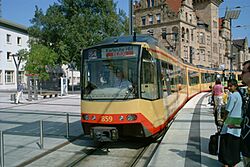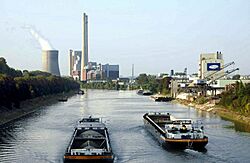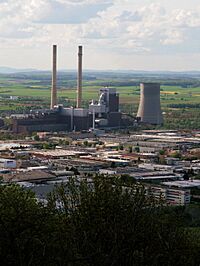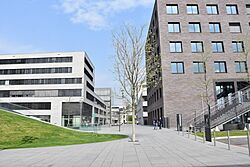Heilbronn facts for kids
Quick facts for kids
Heilbronn
|
|||
|---|---|---|---|
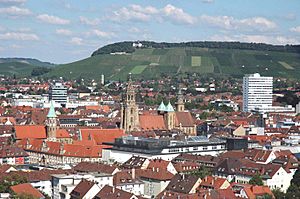
View of the Heilbronn centre of town toward the Wartberg
|
|||
|
|||
| Country | Germany | ||
| State | Baden-Württemberg | ||
| Admin. region | Stuttgart | ||
| District | Urban district | ||
| Elevation | 157 m (515 ft) | ||
| Population
(2022-12-31)
|
|||
| • Total | 128,334 | ||
| Time zone | CET/CEST (UTC+1/+2) | ||
| Postal codes |
74072–74081
|
||
| Dialling codes | 07131, 07066 | ||
| Vehicle registration | HN | ||
Heilbronn is a city in northern Baden-Württemberg, Germany. It is surrounded by the Heilbronn District.
For a long time, Heilbronn was an important place for trade. In the early 1800s, it became a center for new industries in the region. Sadly, the old part of Heilbronn was almost completely destroyed during a bombing raid in World War II on December 4, 1944. It was rebuilt in the 1950s. Today, Heilbronn is a key economic hub for the Heilbronn-Franken region.
The city is famous for its wine. It is also known as Käthchenstadt, named after a character from a play by Heinrich von Kleist called Das Käthchen von Heilbronn.
Contents
Geography of Heilbronn
Heilbronn is in the northern part of the Neckar river basin. It sits at the base of the Wartberg hill, which is 308 meters (about 1,010 feet) high. The city is on both sides of the Neckar River. The highest point in the city is the Schweinsberg mountain, at 372 meters (about 1,220 feet). Heilbronn is close to the Swabian-Franconian Forest Nature Park and is surrounded by vineyards.
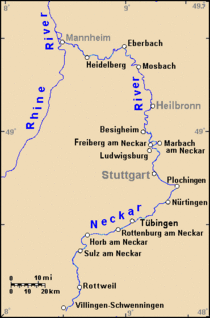
Heilbronn is an important economic center for its region. It also serves many nearby towns and communities.
Neighboring Communities
Heilbronn shares its borders with several towns and cities. These are all part of Heilbronn County. Some of these include Bad Wimpfen, Neckarsulm, Weinsberg, Flein, and Lauffen am Neckar.
City Sections (Boroughs)
The city of Heilbronn is divided into nine main sections, called boroughs:
|
|
Climate in Heilbronn
| Climate data for Heillbronn (1991-2020) | |||||||||||||
|---|---|---|---|---|---|---|---|---|---|---|---|---|---|
| Month | Jan | Feb | Mar | Apr | May | Jun | Jul | Aug | Sep | Oct | Nov | Dec | Year |
| Daily mean °C (°F) | 2.2 (36.0) |
3.0 (37.4) |
6.8 (44.2) |
11.0 (51.8) |
15.1 (59.2) |
18.5 (65.3) |
20.2 (68.4) |
19.7 (67.5) |
15.2 (59.4) |
10.0 (50.0) |
6.0 (42.8) |
3.0 (37.4) |
10.9 (51.6) |
| Average precipitation mm (inches) | 52.2 (2.06) |
45.9 (1.81) |
50.8 (2.00) |
39.0 (1.54) |
71.9 (2.83) |
66.0 (2.60) |
77.6 (3.06) |
65.1 (2.56) |
57.1 (2.25) |
62.1 (2.44) |
57.7 (2.27) |
66.5 (2.62) |
711.9 (28.04) |
| Mean monthly sunshine hours | 51.5 | 72.4 | 119.7 | 173.3 | 201.6 | 202.8 | 209 | 198.1 | 148 | 102 | 50.5 | 39.4 | 1,568.3 |
| Source: Deutscher Wetterdienst | |||||||||||||
History of Heilbronn
Early Times (Before 1200 AD)
People have lived in the Heilbronn area since the Old Stone Age, about 30,000 BC. The fertile land near the Neckar River made it a good place for early farmers. Later, the Celts mined salt here.
Around 81–96 AD, the Romans built a castle in what is now Böckingen. This was part of their border defense, called the limes. Around 260 AD, the Alamanni people took over the area. Between the 4th and 7th centuries, the region became part of the Frankish Empire.
Heilbronn was first mentioned in a document in 741 AD as villa Helibrunna. This name means "healing well," hinting at a special well near an old church. In 1050, documents show a large community of Jews lived here. The city was also allowed to hold markets and make coins.
From 1200 to 1500
In 1225, Heilbronn became part of the Hohenstaufen Empire. This meant it was a fortified city with walls and ditches. Later, the Teutonic Knights built the Deutschhof here, which was one of their homes. Their church building was expanded over time.
In 1281, Heilbronn became a "regal city" under King Rudolf I. This meant it was ruled by a royal official and a council led by a mayor. Around 1300, the first city hall was built. The city also gained the right to change the Neckar River, which helped build dams and harbors. This made Heilbronn attractive to merchants.
In 1371, Heilbronn became an Imperial Free City. This meant it only had to answer to the Emperor, not local rulers. Merchants and craftspeople gained more power in the city council. This stability helped the city grow, and many old buildings, like the Kilianskirche, were built around this time.
From 1500 to 1700
In 1525, during the German Peasants' War, rebellious peasants took control of Heilbronn for about a month. They attacked churches and city buildings. After their army was defeated, their leader was executed.
In 1528, the city became Protestant during the Protestant Reformation. The Kilianskirche tower was finished in 1529, becoming an important Renaissance building. Heilbronn joined the Schmalkaldic League in 1538, a group of Protestant states. However, Emperor Charles V defeated them.
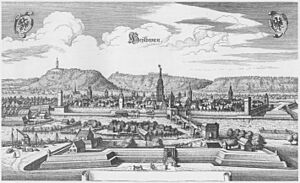
During the Thirty Years' War (1618–1648), Heilbronn suffered greatly. It was occupied by different armies, including imperial, Swedish, and French troops. The city was not free from soldiers until four years after the war ended in 1648.
From 1700 to 1900
In 1802, Heilbronn lost its status as an Imperial Free City. It became part of Württemberg. In 1806, Württemberg became a kingdom.
The Industrialization era began in Heilbronn around 1820. The city became connected by train to Stuttgart, which helped its industries grow. By the end of the 19th century, Heilbronn was a major industrial city in Württemberg.
In 1892, Heilbronn became the first city in the world to get long-distance electric power from a power plant in Lauffen.
From 1900 to 1945
After World War I, Heilbronn became part of the Free People's State of Württemberg. The city had many workers and became known as a "red hot spot" due to strong support for the SPD.
In 1938, Heilbronn became an independent city and the main town of Heilbronn County. Several nearby communities joined the city, making its population grow to 72,000. The port on the Neckar River became one of the ten largest inland ports in Germany.
On November 10, 1938, the Heilbronn synagogue was destroyed during the Kristallnacht. The Jewish community in the city was almost completely wiped out.
During World War II, starting in 1942, salt mines near Heilbronn were used to store art and important industrial goods. Forced laborers from concentration camps worked to expand these mines.
Heilbronn was bombed by Allied forces about 20 times. On September 10, 1944, a large raid targeted the city, causing much damage and killing many people. The Kilianskirche was burned out. After a ten-day battle, the war ended for Heilbronn when the U.S. Army occupied it on April 12, 1945.
Second Half of the 20th Century
After the war, the city began the huge task of rebuilding. Important milestones included the reopening of the historic city hall in 1953 and the community center. Heilbronn became part of Baden-Württemberg in 1952.
In 1968, the A 6 highway to Mannheim opened, which was important for the economy. Later, other highways were completed, making Heilbronn a key transport center in southern Germany. Many large companies then opened offices there.
In 1970, Heilbronn's population went over 100,000, making it a "major city" (Großstadt). More communities were added to the city in the 1970s. The city center was turned into a pedestrian zone, and the city theater reopened in 1982.
In the 1980s, nuclear missiles were stationed near Heilbronn. After a treaty was signed in 1987, these missiles were removed.
21st Century
In 1998, Heilbronn was connected to the S-Bahn train network, which helped transform the city center. This network was expanded further in 2005 and 2013.
In 2005–06, Heilbronn became the first UNICEF children's city in Germany. In 2019, Heilbronn hosted the Bundesgartenschau, a large garden and city exhibition, which attracted over 2.3 million visitors. Part of the exhibition site is now being turned into a new urban area called Neckarbogen.
New buildings in recent years include two Neckar bridges, shopping centers, the experimenta Science Center, and the Bildungscampus. In 2021, the state of Baden-Württemberg decided to place its new innovation park for artificial intelligence in Heilbronn.
Religion in Heilbronn
Since the Franks settled here around 500 AD, the area has been mostly Christian. The Kilianskirche was mentioned in 741 AD.
Around 1050, a significant Jewish community lived in Heilbronn. However, in 1298, many Jews were killed during a violent event. In 1490, Jews were forced to leave the city.
In 1524, Johann Lachmann led the Protestant Reformation in Heilbronn. The city became Lutheran and remained so for centuries. Catholics were not welcome, and Jews were not allowed to settle there again for a long time.
The Age of Enlightenment brought religious freedom to Heilbronn. From 1803, Jews and Catholics were again allowed to live in the city. By the 1860s, Jews had equal rights as citizens. Today, Protestants are still the majority in Heilbronn.
Around 1920, the first groups of Jehovah's Witnesses formed. During the Third Reich, their community suffered greatly, and many members died in concentration camps. Similarly, the Jewish community was almost destroyed after their synagogue was burned down.
Since the 1970s, many people from Islamic or Russian-Orthodox countries have moved to Heilbronn. Because of this, these faiths are now practiced by a growing part of the population.
Population Growth (Demographics)
The numbers below show how Heilbronn's population has changed over the years.
|
|
¹ Census data
Main Sights in Heilbronn
Buildings to See
- Historic manual crane
- Bollwerksturm (a tower)
- Deutschhof (a historic building complex)
- Community centre "Harmonie"
- City Hall with its old astronomic clock
- Käthchenhaus at the market place
- Trappenseeschlösschen (a small castle by a lake)
Churches to Visit
- Kilianskirche (Protestant): Its tower from the early Renaissance is a symbol of the city.
- Deutschordensmünster St.-Peter-und-Paul (Catholic)
- Nikolaikirche (Protestant)
Museums to Explore
- Museum of Natural History
- City Gallery Deutschhof
- Museum of Archaeology
- Kleist-Archiv Sembdner (an archive about the writer Heinrich von Kleist)
- South-German Train Museum Heilbronn
Other Interesting Places
- Old cemetery (now a park since 1882)
- Viewing tower on the Wartberg hill: Offers a great view of Heilbronn.
- Ehrenfriedhof (Cemetery of Honor) for victims of the 1944 air raid.
- Siebenröhrenbrunnen (a fountain)
- Trappensee (a lake)
Culture in Heilbronn
Language Spoken
Heilbronn is located where the Swabian and South Franconian dialects of German meet.
Theater Scene
The Heilbronn municipal theatre offers drama, musicals, and opera. It has several stages, including the main theatre, the Logentheater, Salon 3, and BOXX.
The Theaterschiff Heilbronn is a unique theater on the Neckar River. It also hosts different performances.
Museums and Art
The Heilbronn's municipal museum in the Deutschhof has art, sculptures, and exhibits on the city's history. It also covers archaeology and the history of the Earth. The museum focuses on local artists and has a special collection of small sculptures.
The Deutschhof also houses the House of City History. This museum has a permanent exhibition about Heilbronn's past. Admission to these city museums is free.
The Kunsthalle Vogelmann is a city exhibition hall that focuses on modern art. It was built in 2009/2010.
The Literaturhaus Heilbronn opened in 2020 in the Trappenseeschlösschen. It hosts readings, discussions, and workshops about literature. It also includes the Kleist Archiv Semdner.
In 2009, experimenta, the largest science center in southern Germany, opened in Heilbronn. It was expanded in 2019 with a new building.
Music Scene
The Württemberg Chamber Orchestra Heilbronn (WKO) is a well-known German orchestra. It was founded in 1960.
Since 2015, the Classic Open Air Festival takes place in the city center. It offers free outdoor concerts by local orchestras and music groups.
The Heilbronn municipal music school is located in the K3 theatre forum. Cave 61, founded in 1961, is famous for its jazz concerts.
Other Cultural Places
Heilbronn supports various cultural projects. These include the art and cultural center Zigarre and the Kommunales Kino (community cinema). There is also the free cultural center Maschinenfabrik, which opened in 2021.
Events and Festivals
- In February, people enjoy the Pferdemarkt (Horse Market).
- In May, the Trollinger marathon takes place.
- The Heilbronner Volksfest is the city's largest festival. It starts in late July and ends in early August.
- In September, there is the Heilbronner Weindorf (Wine Village).
- In November and December, you can visit the Weihnachtsmarkt (Christmas market).
Sports in Heilbronn
FC Heilbronn is a football (soccer) club. It was formed in 2003 from two older clubs.
Heilbronn hosts an annual tennis tournament called the Intersport Heilbronn Open. This is part of the ATP Challenger tour.
Heilbronn is home to the ice hockey team Heilbronner Falken (Heilbronn Falcons). They play in Germany's second ice hockey league. The Eisbären Heilbronn (Heilbronn polar bears) is another ice hockey team.
The „Red Devils“ Heilbronn is a wrestling team that competes in the national wrestling league.
The city has 68 sports clubs with about 30,000 members. They offer many different sports activities.
Economy and Infrastructure
Viticulture (wine growing) has a long history in Heilbronn. It is still a very important part of the city's economy today. Heilbronn has 514 hectares of vineyards, making it one of the largest wine-growing areas in Württemberg. Many vintners here are part of a large cooperative.
The Südwestdeutsche Salzwerke AG (SWS) runs a salt mine in Heilbronn. This mine is connected to another closed mine by a tunnel. In 2004, a new shaft was added to the Heilbronn mine.
Transportation and Roads
Heilbronn is easy to reach by road. It is located near the Weinsberg Intersection, where the A 81 and A 6 highways meet. Other main roads also run through the city. Heilbronn was one of the first cities in Germany to use "Green arrow" signs, allowing drivers to turn right on red lights.
Even though Heilbronn Hauptbahnhof (the central train station) does not have long-distance train service, the city is well connected by train. Several train lines connect Heilbronn to cities like Stuttgart, Würzburg, Heidelberg, and Mannheim.
The Heilbronn and Karlsruhe Stadtbahn light rail systems connect Heilbronn to Karlsruhe. More S-Bahn lines are planned for the future.
Public transportation in Heilbronn includes the S-Bahn and buses. These are all part of the Heilbronner Verkehrsverbund (Heilbronn Transport Association).
The canal port on the Neckar River is one of the ten largest inland ports in Germany.
Power Plant
In the industrial area of Heilbronn, a large coal-powered plant is run by EnBW AG. Its tall chimneys (250 meters) and cooling tower (140 meters) can be seen from far away.
Media and News
Heilbronn is home to a studio of Südwestrundfunk (SWR), a public broadcasting company. They broadcast regional programs from here. The Heilbronner Stimme is a daily newspaper published in the city. There are also free weekly newspapers and monthly city magazines.
Public Services
Heilbronn has several courts, including ones for labor issues and family matters. The city is also an important center for both the Protestant and Catholic churches in the region.
Education and Learning
Heilbronn offers many higher education options, and the number of students has grown a lot. In 2020, Heilbronn was named a "University City."
The main campus of the Hochschule Heilbronn (Heilbronn University) is located here. It was founded in 1961. The business departments of this university are at the Bildungscampus. This campus also hosts other educational and scientific institutions.
Heilbronn has five high schools that prepare students for college (Gymnasiums). There are also four other high schools (Realschulen). The city runs six special-education schools for students with different needs.
There are many primary schools and middle schools in Heilbronn. The city also has professional training schools for various trades.
Several private schools offer additional education options in Heilbronn.
Twin Towns – Sister Cities
Heilbronn has friendly relationships with these cities:
 Béziers, France (since 1965)
Béziers, France (since 1965) Solothurn, Switzerland (since 1981)
Solothurn, Switzerland (since 1981) Stockport, England (since 1982)
Stockport, England (since 1982) Frankfurt (Oder), Germany (since 1988)
Frankfurt (Oder), Germany (since 1988) Słubice, Poland (since 1998)
Słubice, Poland (since 1998) Novorossiysk, Russia (since 2019)
Novorossiysk, Russia (since 2019)
Notable People
Images for kids
See also
 In Spanish: Heilbronn para niños
In Spanish: Heilbronn para niños




